The 21 Best Thai Dishes to Try When Visiting Bangkok and Chiang Mai
Essential Thai Foods You Have to Try at Least Once
Whether you like your food spicy or Thai spicy, there’s Thai dishes out there for everyone. Although Thai food is near synonymous with being extra spicy, it is also characterized by the giant sweet tooth of Thai culture. As often as I’ve heard someone ask for Thai spicy when ordering their favorite Thai dish (usually from a street food vendor), I’ve heard foreigners ask for regular sweet instead of Thai sweet just as much. It’s a country where asking for ‘no sugar’ often means ‘less sugar than how Thais like it’.
Top 9 Most Popular Thai Dishes
- Khao Soi (Chiang Mai curry noodles)
- Pad Thai (Thai stir-fried noodles)
- Kaeng Massaman (Massaman Curry)
- Tom Yum Goong (Hot and Sour Soup with Shrimp)
- Som Tum (Spicy Green Papaya Salad)
- Pad Kra Pao (Thai Basil Stir-Fry)
- Khao Man Gai (Boiled chicken with rice)
- Gaeng Keow Wan Gai (Thai Green Curry)
- Pad Woon Sen (Stir-fried glass noodles)
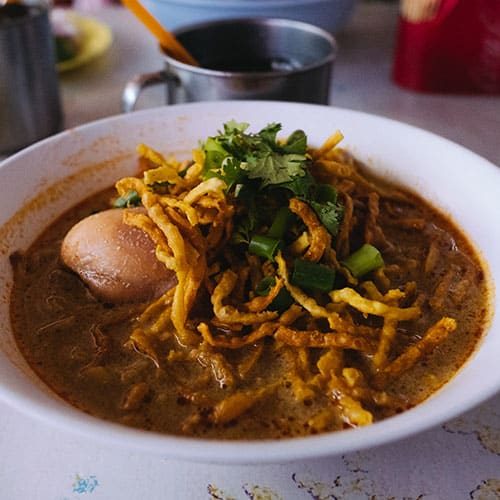
Khao Soi (Chiang Mai curry noodles)
Khao Soi is a curry noodle soup from Northern Thailand, garnished with crispy fried noodles. It is most commonly served with chicken (khao soi gai) and comes with lime, chili paste, raw shallots and pickled cabbage on the side. Khao soi is a staple of Chiang Mai cuisine, while it can be difficult to find in Bangkok.
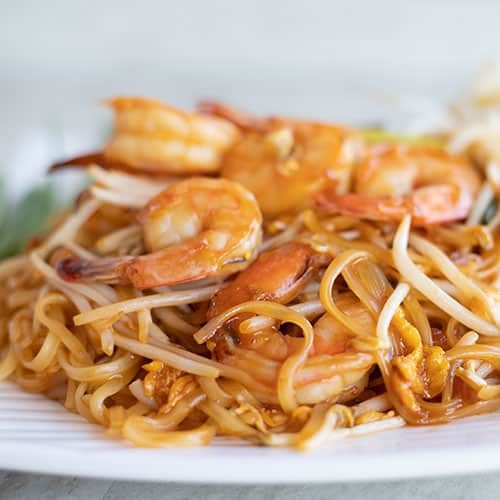
Pad Thai (Thai stir-fried noodles)
Pad Thai is by far the most famous Thai food globally, but it isn’t eaten by Thais as much as you’d think. Pad Thai consists of rice noodles, peanuts, scrambled egg, bean sprouts and a choice of chicken, beef or tofu. It is made by sauteing all the ingredients in a wok and then tossed in the signature tangy salty pad thai sauce.
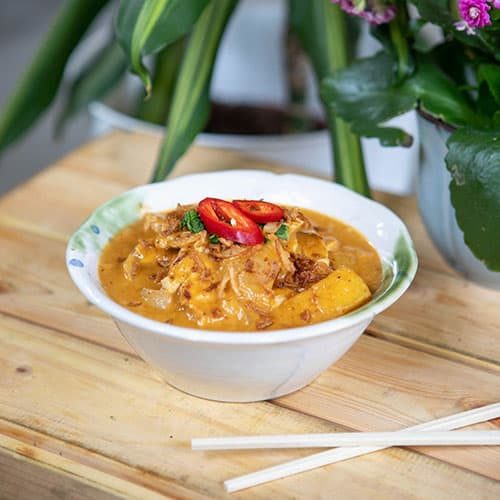
Kaeng Massaman (Massaman Curry)
Massaman curry is an Indian-fusion dish that stands out from other Thai curries. Originally brought to the region by Muslim traders, it makes use of both Indian (cardamom, cinnamon, bay leaves, potato) and Thai ingredients (chili peppers, coriander, lemongrass, shrimp paste, garlic). Although its exact origins are debated among food historians, it is widely accepted that massaman curry has Indian and Malay influences.
📷 Photo Credit: Camile Thai Facebook
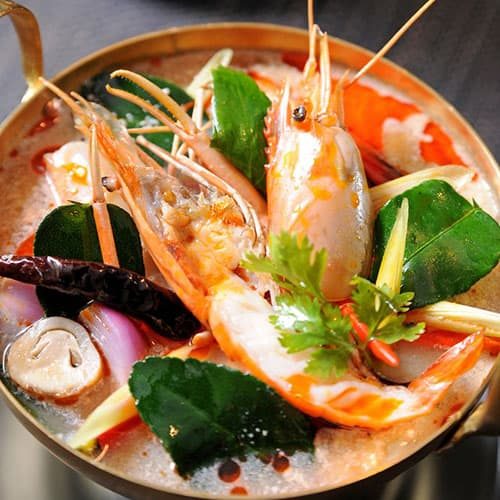
Tom Yum Goong (Hot and Sour Soup with Shrimp)
Tom yum, or tom yam, is a Thai-Chinese hot and sour soup typically served with shrimp. Tom yum is a simple light soup made with fresh lemongrass, galangal, chilies, kaffir lime leaves, fish sauce and a splash of fresh lime juice at the end.
Like many other Thai dishes, it’s tough to replicate the authentic taste of Tom Yum made in the motherland. You will likely have trouble finding galangal (Thai ginger) outside of Asia. Although not mandatory for a good tom yum, galangal is an herb used to neutralize the strong fishy aroma. Try your local Asian supermarket and cross your fingers!
📷 Photo Credit: Temple of Thai
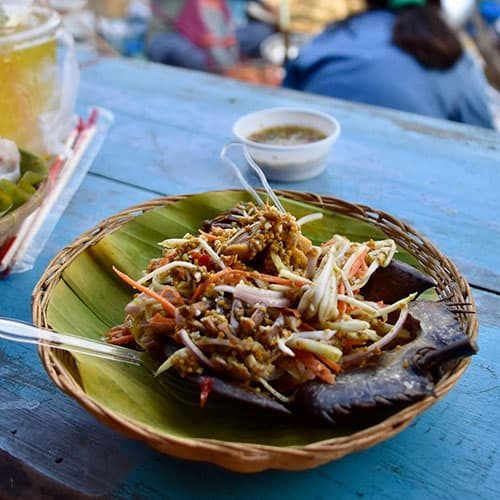
Som Tum (Spicy Green Papaya Salad)
Originating from Laos as ‘tam som’ or ‘tam maak hoong’, som tum is a unique salad that is popular throughout Southeast Asia. The most popular version of som tum served in Thailand is served with dried shrimp and peanuts, often eaten with sticky rice and other Northeastern Thai dishes. Sometimes the dried shrimp is substituted with salted crab (som tum pbooh).
📷 Photo Credit: Brian Bone
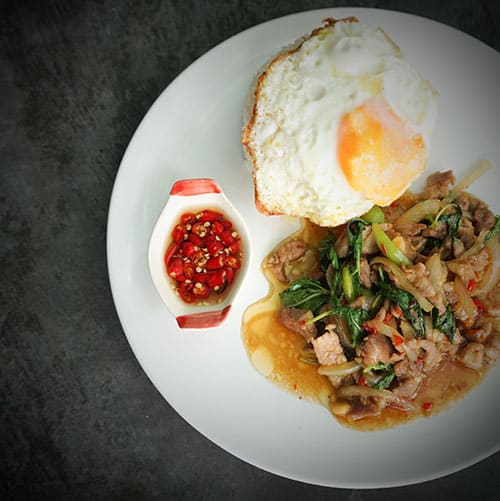
Pad Kra Pao (Holy Basil Stir-Fry)
Pad kra pao is the closest cultural equivalent to a sandwich in Thai cuisine. This rustic, spicy stir-fry features the incredible aroma of holy basil, served with rice and topped with a fried egg. It’s a quick and easy meal found in almost any street-side restaurant, street food vendor or food court. The slightly runny fried egg brings a creaminess when prepared Thai style: fried in plenty of oil so that the egg whites have bubbly brown edges.
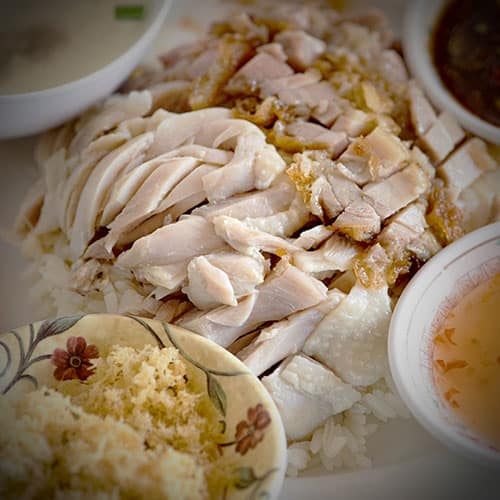
Khao Man Gai (Boiled chicken with rice)
Khao man gai is the Thai version of Hainanese chicken rice; it is one of the simplest meals and a testament to a chef’s prowess. Simplicity in cooking is tough to achieve while satisfying the taste buds of many. The dish is served as a chicken rice soup, often with spicy, congealed chicken blood as an optional side.
In Bangkok, you’ll find chicken rice carts or Khao man gai specialty restaurants without even trying. The best place in Thailand for this dish is เม้งโภชนา (เล็ก) เจริญกรุง 59 in Bangkok, located at Charoenkrung Soi 59. This place is locally famous among Thais and expats as a hotspot for the only place to eat khao man gai. I was lucky enough to live across the street for a number of years, filling my cravings on a whim any day of the week.
📷 Photo Credit: Atsushi Hariu
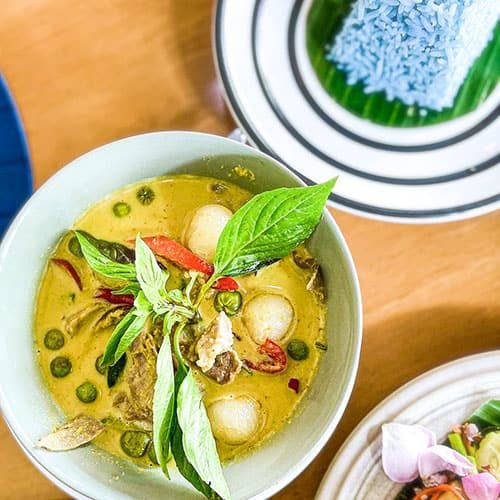
Gaeng Keow Wan Gai (Thai Green Curry)
The secret of Thai green curry paste is that it’s fried in coconut cream at the start of preparation. The coconut cream absorbs the paste without any need for oil in the pan. Coconut cream is the more traditional way to make a Thai green curry, but this is often substituted with coconut milk for a less thick curry experience.
Many will claim that store-bought curry pastes do the trick just fine, but the authentic Thai flavour lies in the mortar and pestle.
📷 Photo Credit: Nicha The Wanderer ณิชาพาตะลอน
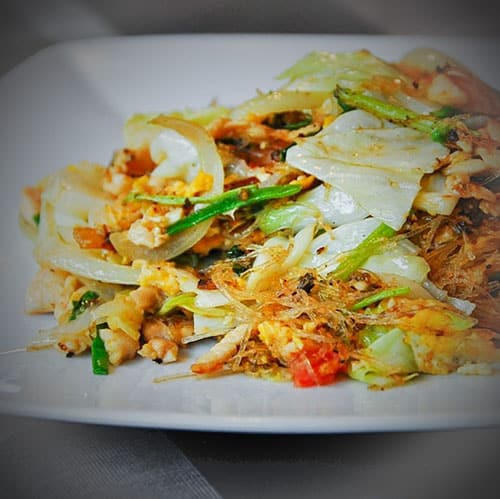
Pad Woon Sen (Stir-fried glass noodles)
Pad woon sen is a classic Thai dish almost as popular as pad thai itself! Glass noodles are stir-fried with crunchy vegetables (usually carrots and shredded cabbage), grilled chicken, tomatoes, onions and garlic. The silky smooth glass noodles (also known as bean thread noodles or cellophane noodles) are often mistaken for rice vermicelli when uncooked. The main difference between these types of noodles is that once cooked, glass noodles are translucent and rice vermicelli has a white, opaque appearance.
📷 Photo Credit: Street Food Hunters
Thai Curries
Every great curry begins making an excellent curry paste by hand with a mortar and pestle. Although some will swear by the convenience of food processors for making curries, this is considered taboo in the Thai culinary world. More accurately, it can be outright offensive since it’s rare you’d find a food processor in a Thai kitchen to begin with.
As urbanization of Thailand spreads, many traditions of authentic Thai cuisine have been lost culturally. You’ll find processed sugar instead of cane sugar in almost every Thai household but in more recent years, there is also a growing trend in using store-bought curry pastes. While we normally wouldn’t recommend store-bought over homemade, these pastes are made fresh daily and are well worth the money if you don’t have enough time to cook.
Suggested Reading: How to Make Traditional Thai Curry Pastes
Types of Thai Curry Dishes
- Massaman Curry
- Khao Soi (Chiang Mai Noodles)
- Green Curry
- Red Curry
- Penang Curry
- Yellow Curry
- Northern Thai Burmese Pork Curry
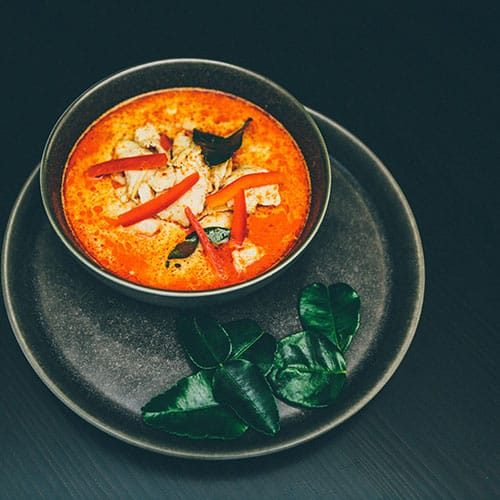
Kaeng Phet (Thai Red Curry)
Thai red curry is a popular Thai dish made from cooking red curry paste in coconut milk and adding your protein of choice (chicken, beef, pork, shrimp, tofu). The redness in kaeng phet comes from the copious amounts of dried red chilies used in the curry paste.
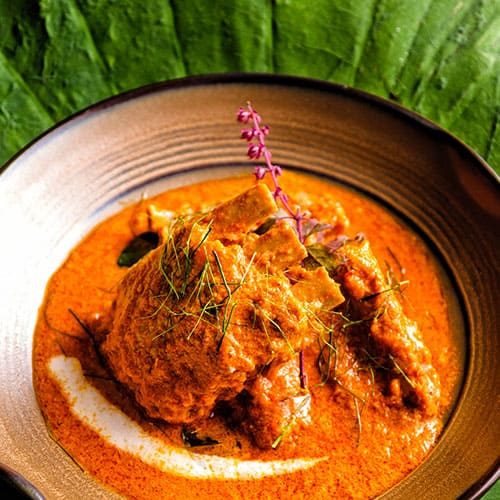
Phanaeng (Thai Panang Curry)
Phanaeng (also spelled phanang or panang) is another type of Thai red curry dating back to 1890, featuring a salty, sweet taste and a zesty hint of kaffir lime. Most commonly served with pork, phanaeng is a creamy curry made with no liquid ingredients other than coconut milk.
📷 Photo Credit: The Local by Oam Thong Thai Cuisine
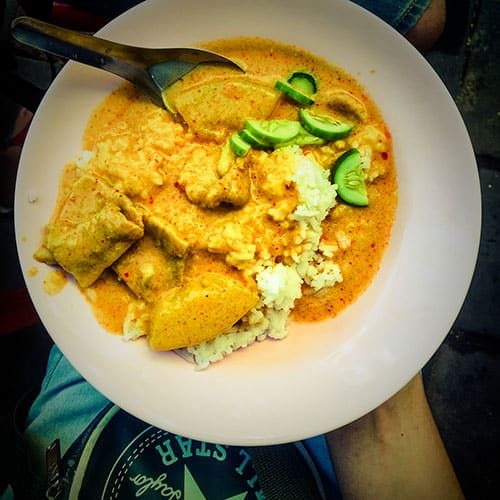
Kaeng Kari (Thai Yellow Curry)
Don’t mistake kaeng kari for kaeng luaeng: While kaeng luaeng directly translates to “yellow curry”, kaeng kari (curry soup) is the famous dish you’re looking for!
With origins in India, Thai yellow curry is a fusion dish incorporating Indian ingredients with Thai spices. It has a powerful, vibrant taste, accompanied by carrots and potatoes to fill you up. You can commonly find yellow curry served on street-side restaurants so find a plastic stool and get ready to fill your belly.
📷 Photo Credit: Kyle Weng
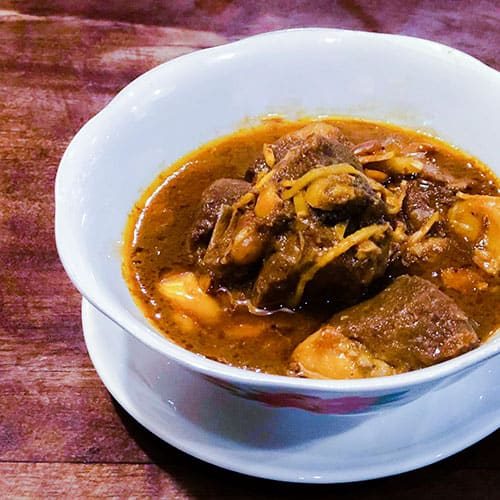
Kaeng Hunglay (Northern Thai Burmese Pork Curry)
Kaeng hunglay is a curried-stew from Northern Thailand with Burmese roots, typically made from pork belly or other fatty pork. Its defining trait is the use of Garam Masala, a blend of spices found in Burmese and Indian cuisine. If you’re a fan of Indian food, you’ll love this curry. It has all the rich and hearty traits of a great stew, while showcasing the sweet and sour tastes of traditional Thai cooking.
📷 Photo Credit: Thai Cookbook TV
Thai Desserts
No one ever complained about an abundance of fresh fruit! But I’ve heard plenty of complaints about Thai desserts being too sweet. Too sugary, to be exact!
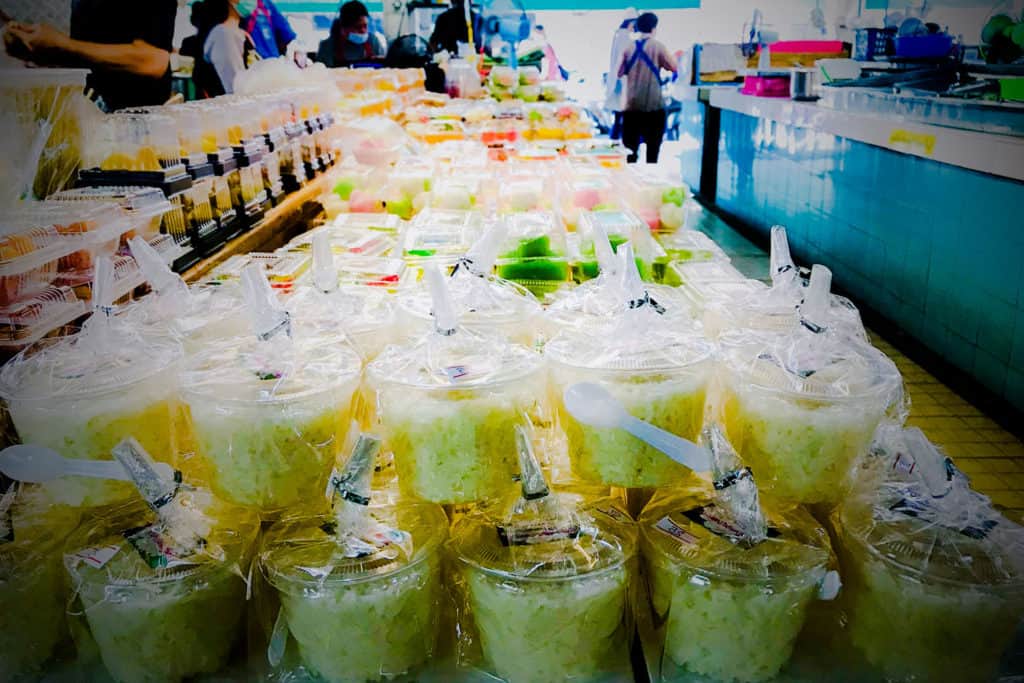
How to Say “No Sugar” or “Not Sweet” in Thai
If you’re like me (a foreigner), you’ll want to tell your server mai waan, which directly translates to “not sweet”. It’s a good catch-all for ordering coffee, tea or dessert to make sure you aren’t overwhelmed by sweetness. However, some Thais will interpret mai waan as meaning “little sugar”, rather than “no sugar”. In this case, the magic phrase is mai waan loei, or “no sugar at all”.
Top 6 Most Popular Thai Desserts
- Khao Niao Mamuang (Mango Sticky Rice)
- Khao Niao Toorien (Durian Sticky Rice)
- Itim Kati (Coconut Ice Cream)
- Khanom Buang (Thai crispy pancakes)
- Mamuang Nam Pla Wan (Green mango with sweet chili spices)
- Khanom Ba Bin (Grilled coconut cakes)
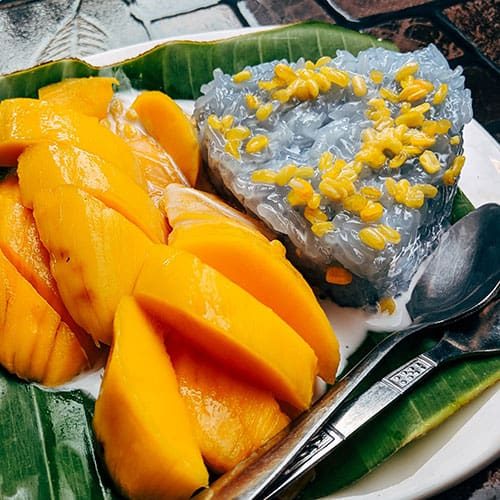
Khao Niao Mamuang (Mango Sticky Rice)
The classic Thai dessert. You’ll find it in every nook and cranny as street food but also at Thai restaurants around the world. It’s a simple treat that is globally celebrated made from just 3 key components: ripe mangoes, high quality coconut milk and Thai sweet rice. Thai sweet rice is sometimes just called sticky rice or glutinous rice, found in most Asian food stores. Sticky rice is always made in a pot on the stove, rather than a rice cooker. The secret to a good Thai sticky rice is bringing it to a gentle boil in coconut water, coconut milk, salt and brown sugar.
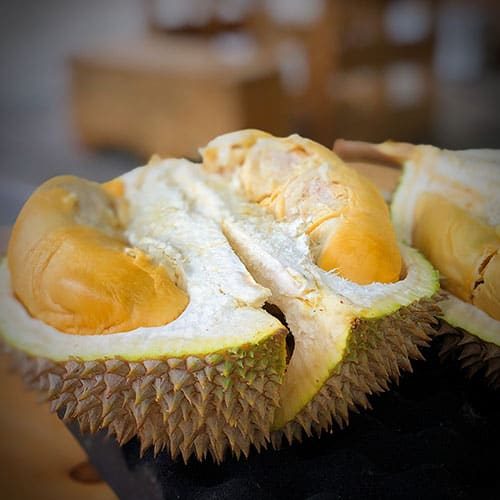
Khao Niao Toorien (Durian Sticky Rice)
Khao niao toorien is a variation on the traditional mango sticky rice, substituting mango for fresh durian. Durian, dubbed the “king of fruits”, is famous for its pungent smell. The aroma of durian is so strong that the fruit is actually banned from most forms of public transportation. When someone cracks open a durian, you’ll know from a block away (literally).
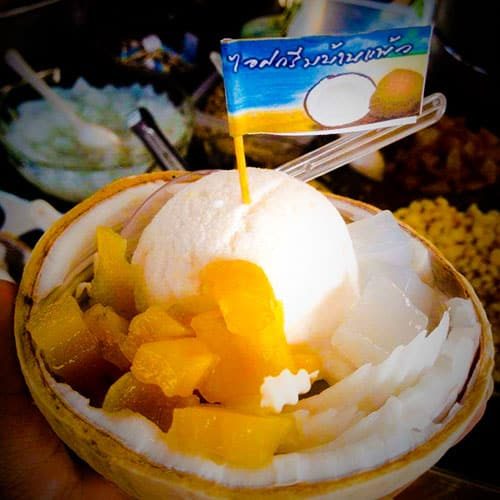
Itim Kati (Coconut Ice Cream)
You haven’t eaten in Thailand if you haven’t capped off a nice meal with coconut ice cream!
It’s a simple non-dairy ice cream made almost entirely from fresh coconut! Authentic Thai coconut ice cream uses the water from the coconut, organic coconut sugar instead of regular sugar and just a little bit of salt. Be on the lookout for regional variations – it isn’t uncommon to find coconut ice cream topped with fresh mango chunks and chopped peanuts.
📷 Photo Credit: You Know You’ve Lived In Thailand when…..
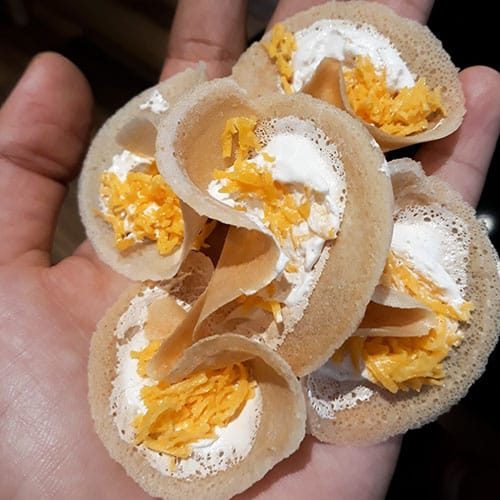
Khanom Buang (Thai crispy pancakes)
Khanon buang is a traditional Thai dessert passed down generation to generation. Dating back roughly 600 years ago, the Thai crispy pancake is a street food that requires precise preparation. It consists of a thin, crispy crepe made from rice flour and is topped with candied duck egg yolk.
📷 Photo Credit: Trương Thị Nhớ
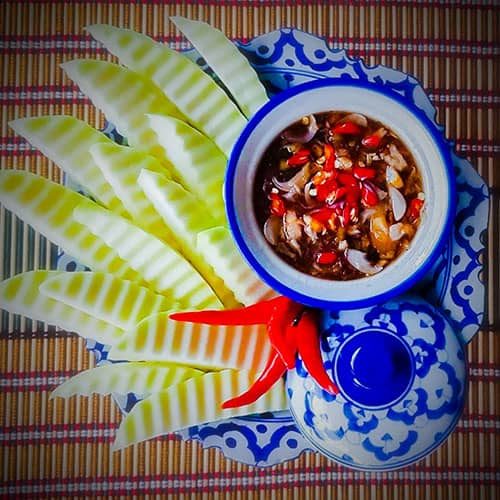
Mamuang Nam Pla Waan (Green mango with sweet chili spices)
Nam pla waan is a Thai fruit dip that turns any sour fruit into an exciting opportunity to drench them in sweet, salty fish sauce. Is fish sauce and fruit a combination I ever expected to recommend? Absolutely not. But it tastes amazing and after a first taste, you’ll drop your suspicions quickly! The sauce is made with palm sugar, fish sauce, shrimp paste, Thai chilies and shallots. The dip is most commonly served with green mango, but underripe pineapple and green apple will make their way to your plate sometimes too.
📷 Photo Credit: We ❤ Non Veg Recipes Facebook Group
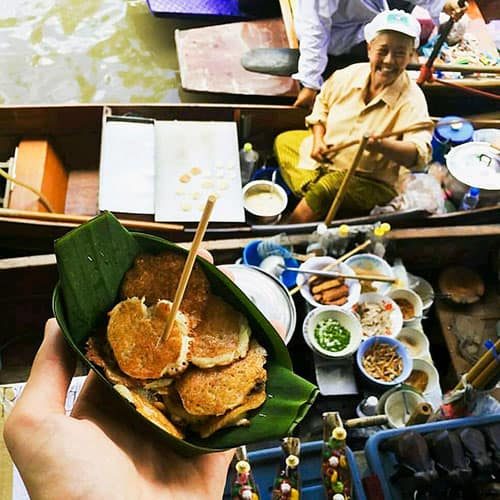
Khanom Ba Bin (Grilled coconut cakes)
Thai coconut pancakes are a staple street food, cooked on a hot griddle. Khanon ba bin is a gluten free dessert that is found almost everywhere in Thailand.
📷 Photo Credit: dmAsia
Coffee from Thailand
Thai café culture has grown rapidly in the past decade. The heat of coffee in Thailand is Chiang Mai, home to internationally acclaimed baristas that have won global competitions. Although Chiang Mai is known as the capital of coffee in Thailand, Bangkok is no slouch either. With a seemingly endless amount of new coffee shops popping up in Bangkok and their widespread availability through GrabFood and FoodPanda, Bangkok is in an exciting era that should be appreciated in full. Although Thai coffee doesn’t pack the same punch as Vietnamese coffee, it makes up for it with rich flavour.
Ristr8o in Chiang Mai is possibly the most internationally famous of all Thai cafés, known around the world as being home of the World Champion Latte. That said, it’s not my favourite – that title belongs to Roastniyom, which is a more locally famous attraction. Whenever I visit Chiang Mai, I take a cab straight from the airport to Roastniyom for their cold brew and croissants!
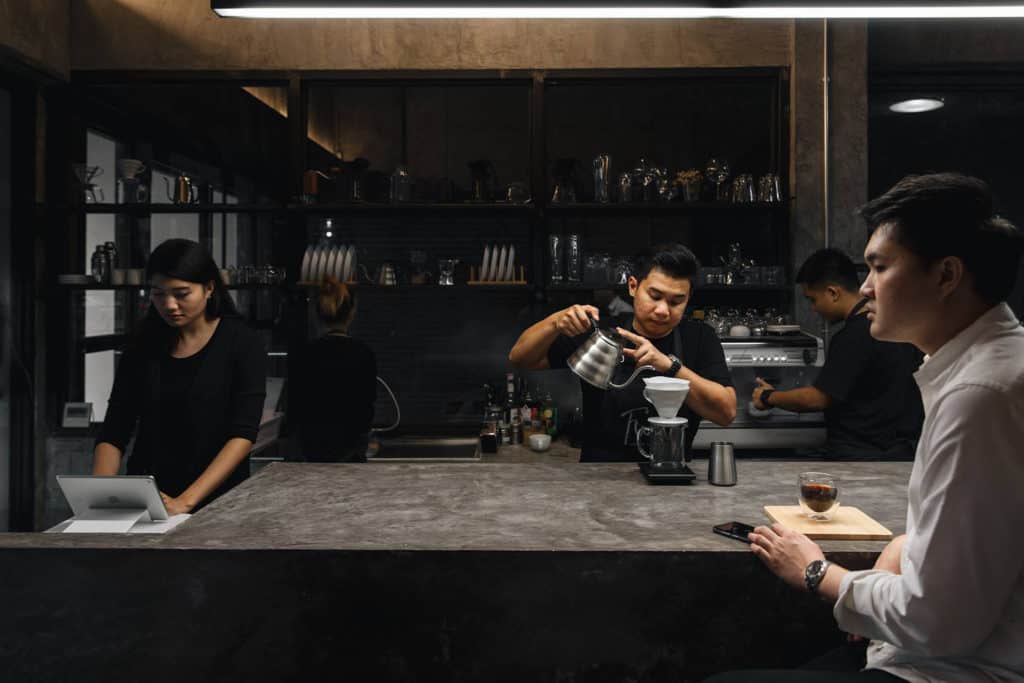
6 Best Cafés in Bangkok
- Rocket Coffeebar (Sathorn)
- Chu Chocolate Bar (Asok)
- Ado-Po Kafe (Yan Nawa)
- Eureka Coffee Tap (Sala Daeng)
- Wanderlust Coffee and Eatery (On Nut)
- Kof Cafe (J Avenue Mall) – Waffle cone lattes!
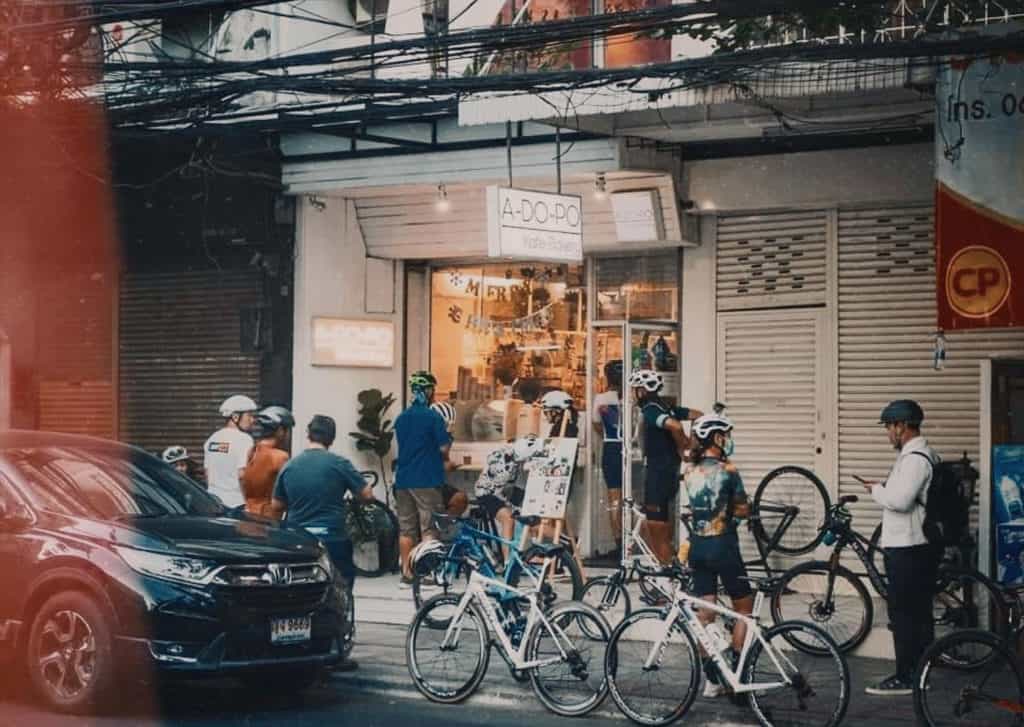
6 Best Cafés in Chiang Mai
- Roastniyom Coffee
- Ristr8o Lab
- Graph Coffee
- Taste Café
- Akha Ama La Fattoria
- Yesterday Café
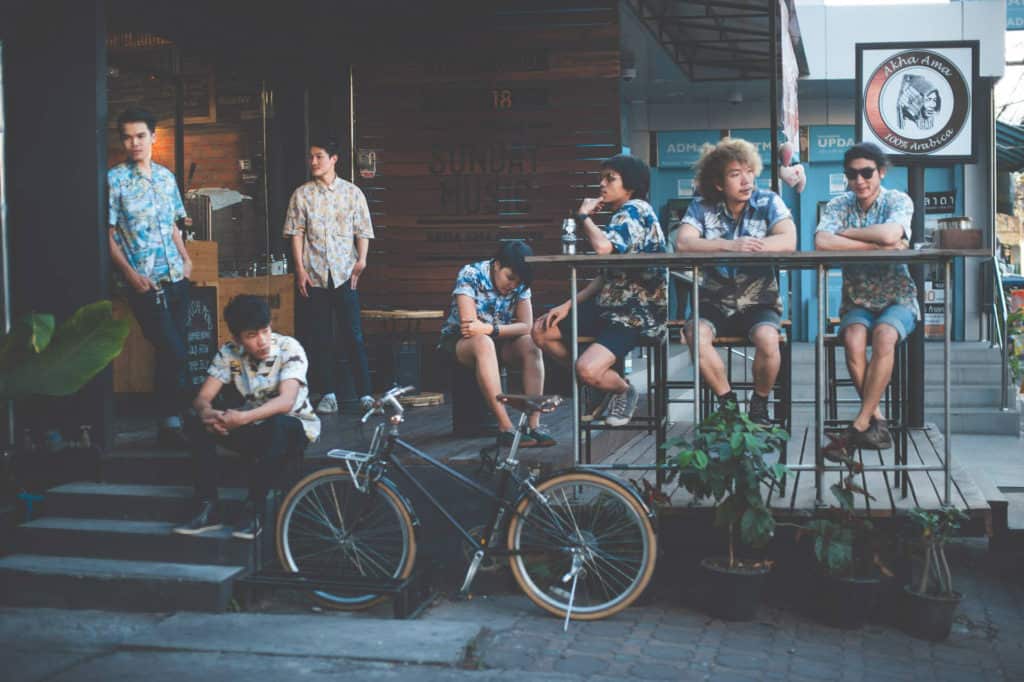
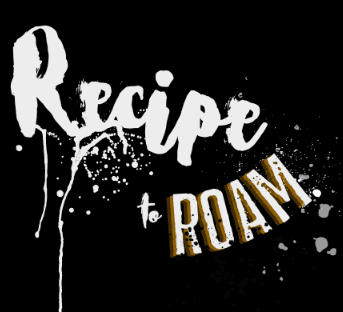
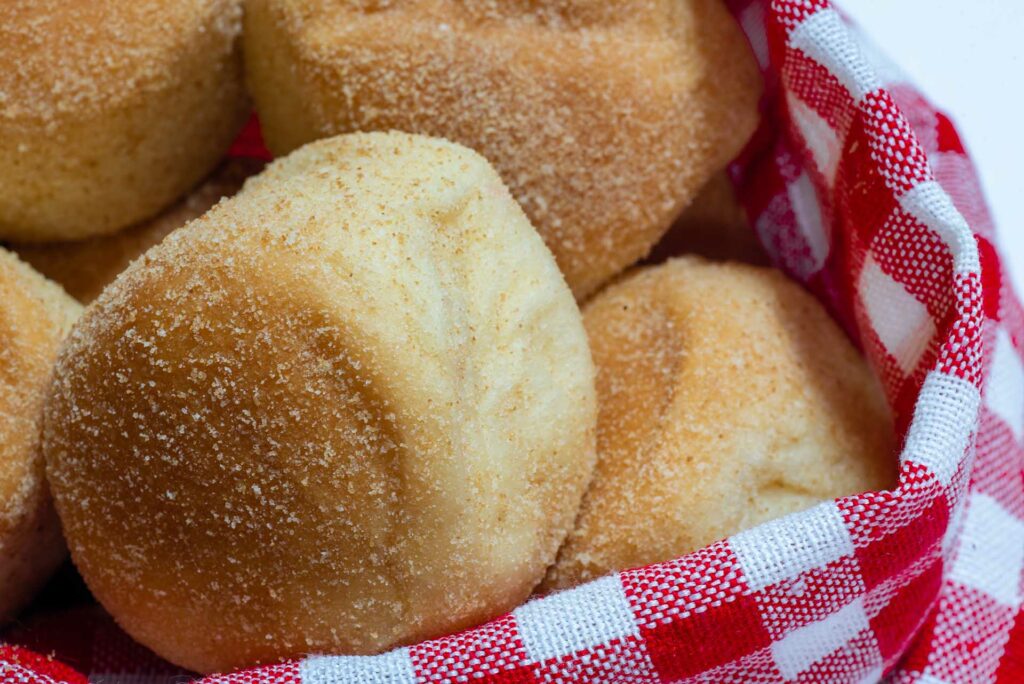
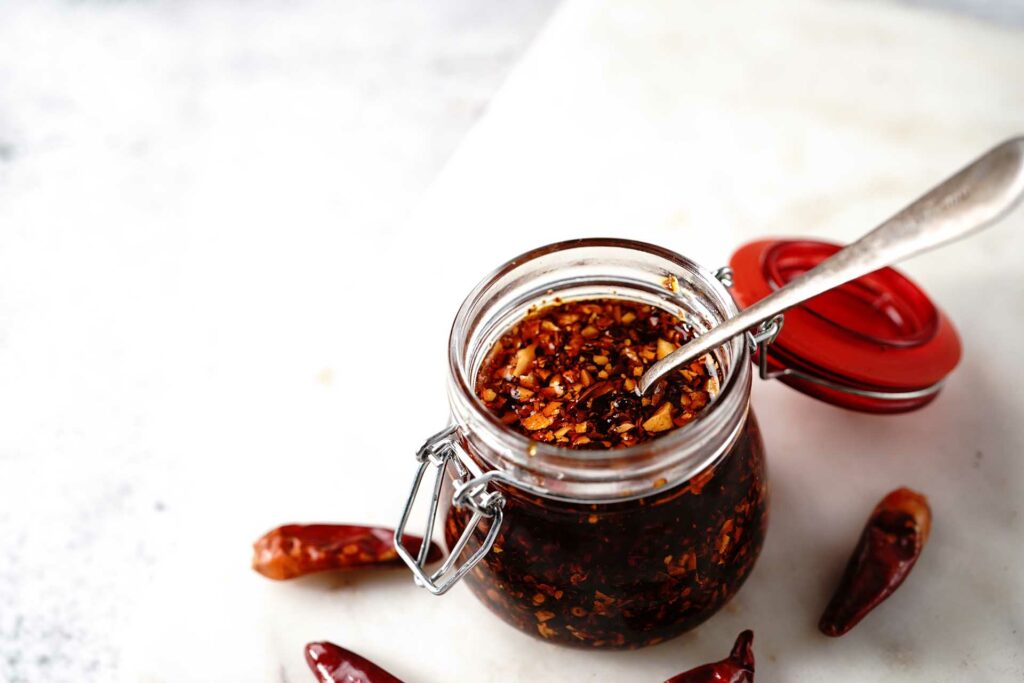
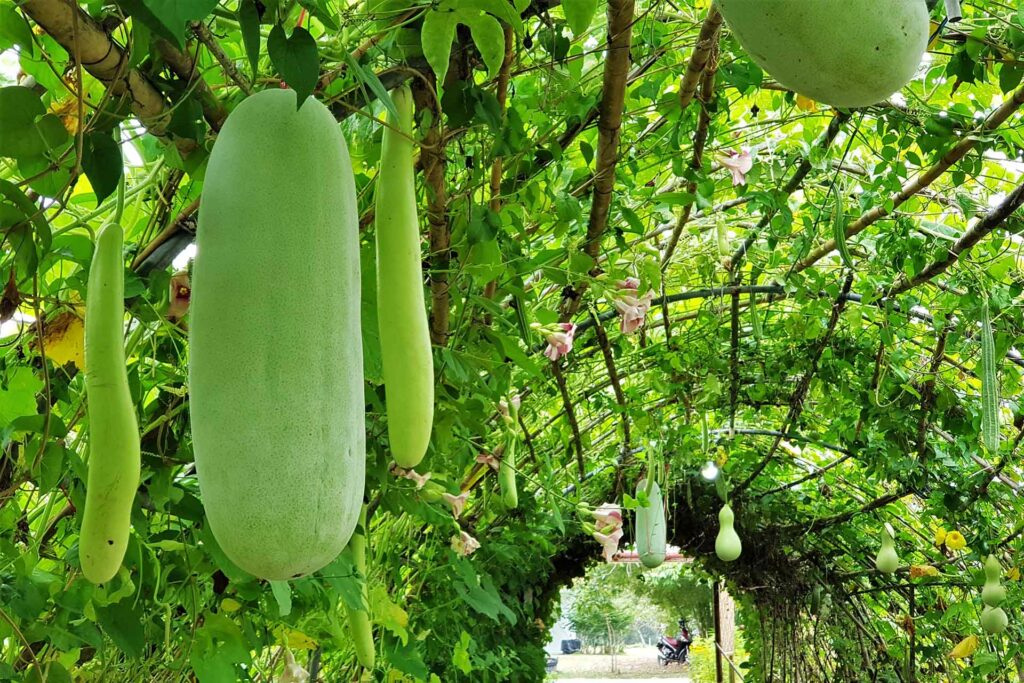
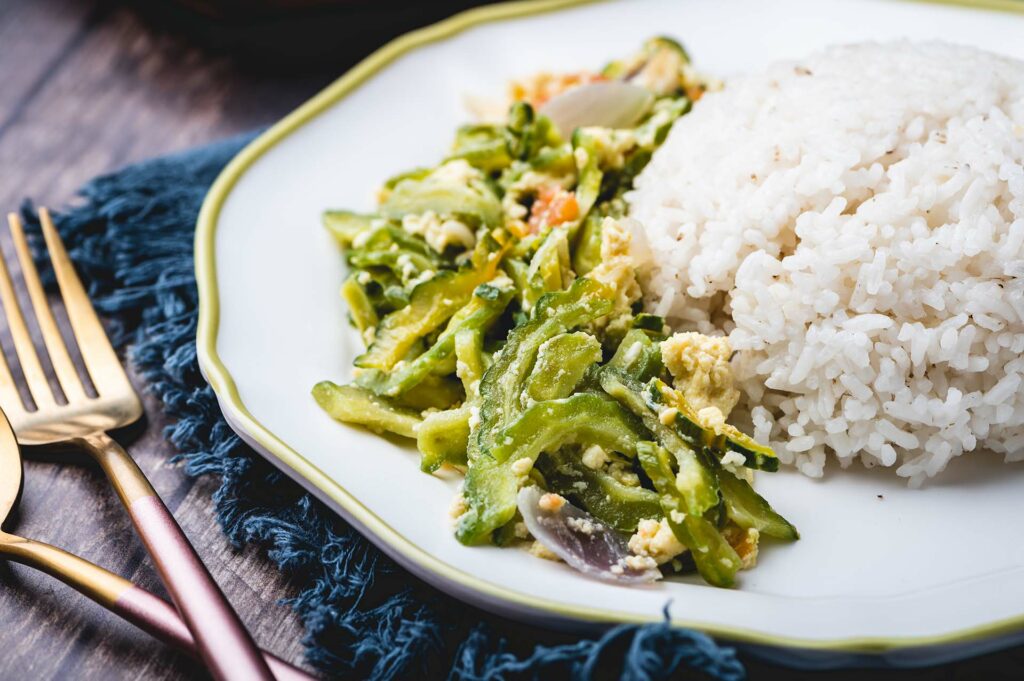
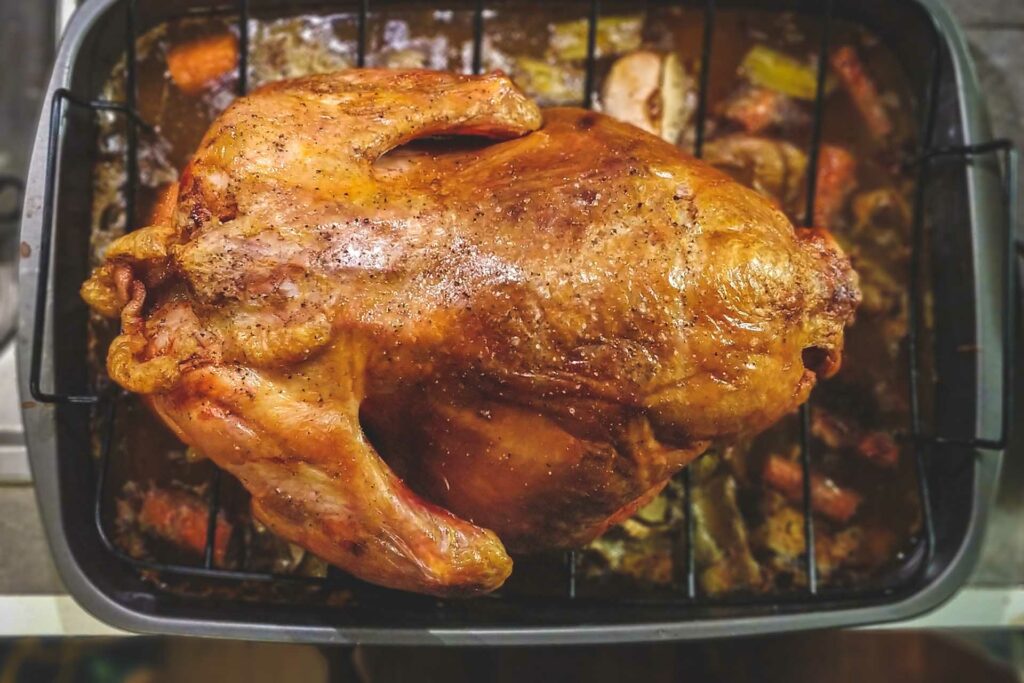
One Response
Hello, thanks for the sharing this blog , this is very helpfull for me , if you want any help regarding best indian Restaurant in Bangkok then contact with Finch Bangkok.